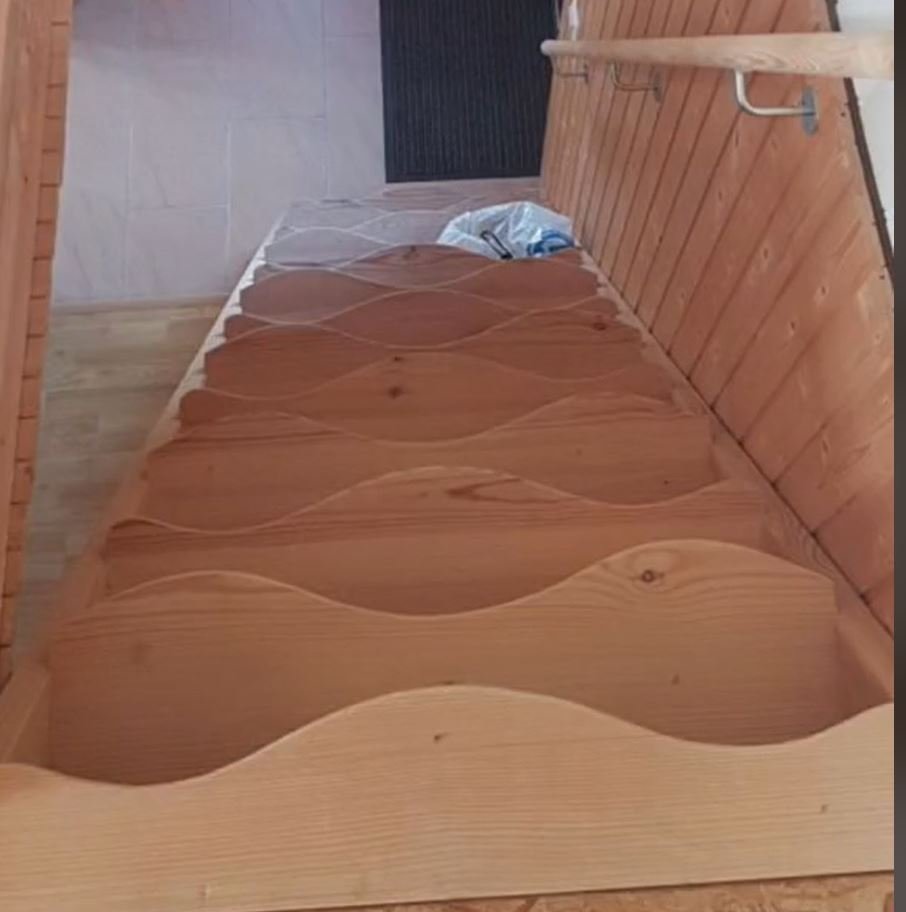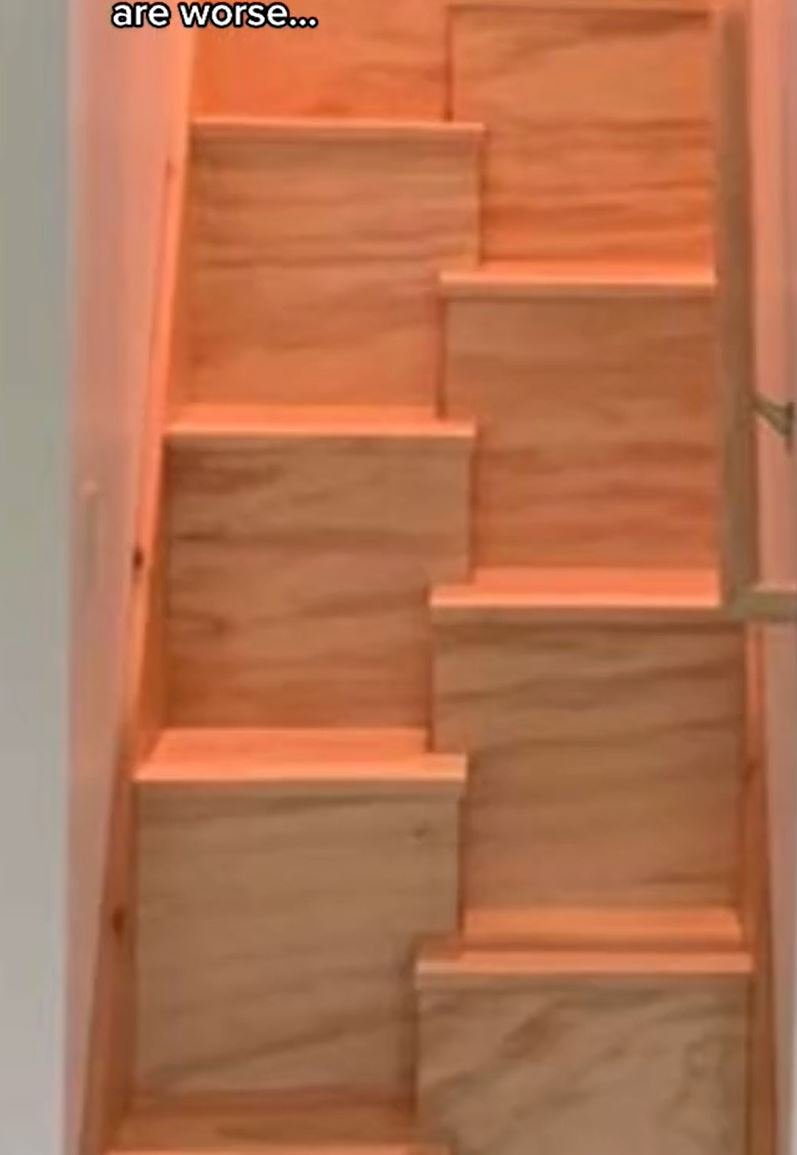Witches’ stairs are a strange but interesting design feature that became popular on TikTok a couple of years ago. Even though they have an unusual history, their name doesn’t really have to do with superstition. Instead, these stairs are a clever design choice. When made and installed correctly, they can be both useful and nice to look at!
Witches’ Stairs aren’t what they Appear.

While the stories about witches’ stairs might sound more interesting, they actually have a very practical purpose. They are really useful in homes with little space, like attics, lofts, and tiny houses. Witches’ stairs are designed to save space while still allowing you to go from one floor to another. Architects often call them “alternate tread stairs.”
How Witches’ Stairs Function

Photo Credit: itsthatrealestatechick | TikTok
Witches’ stairs are designed to save space in two ways. First, each step is only half as wide as regular steps, and the steps are staggered. This makes the staircase narrower than a traditional one. These smaller stairs can also be used for extra storage, like for books or displaying items. According to Scott Schuttner, who wrote “Basic Stairbuilding,” the distance between the steps on one side of an alternating-tread stair is twice the height of the rise, which gives you more space on the steps and makes them safer.
Besides being practical, witches’ stairs meet building codes and safety standards in the U.S. A standard staircase is usually 3 feet wide, while a residential witches’ staircase is typically between 27 and 30 inches wide.
Real Origins

Photo Credit: itsthatrealestatechick | TikTok
In 1985, a businessman named J.M. Lapeyre created a metal version of witches’ stairs. He thought these stairs could be a safe alternative to ladders in commercial and warehouse settings, especially in tight spaces where ladders might not be safe. This design is also used on commercial ships and oil rigs, and it can be called ship stairs or ship ladders, in addition to witches’ stairs and alternate tread stairs.
Misconception

Photo Credit: itsthatrealestatechick | TikTok
When videos of witches’ stairs first appeared on TikTok in 2021, they were linked to an urban legend. According to this legend, these staircases were built in 17th-century Massachusetts to keep witches away during the Salem witch trials because “witches can’t climb up them.” This idea has been proven false, but another rumor suggests that Thomas Jefferson came up with the design. Because of this, witches’ stairs are sometimes called Jeffersonian or Jefferson stairs. However, an original version of the design was also mentioned in a book called “Monckton’s One Plane Method Of Hand Railing and Stair Building,” published in 1888.
Debunking the Myth

Photo Credit: conspiracy___time | TikTok
The exact origins of witches’ stairs are a bit unclear, but one thing is clear: there’s no historical evidence that they were designed to keep witches away. Historian Robin Briggs has studied many historical sources and found no mention of stairs that could disable witches. Interestingly, some people with these unique staircases also buried “witch bottles” or included dead cats in their homes for protection against witchcraft, but Briggs calls this idea “pure disinformation.” He notes that the closest belief was that putting a broom over the door would trap a witch inside.
While it’s fun to think about myths and legends, it’s also interesting to know the real history of witches’ stairs. Regardless, they offer a unique and decorative alternative to regular staircases, adding a fun and quirky touch to home design.
I Found Photos of Me with a Newborn, but I Don’t Remember Ever Being Pregnant

I opened a box of forgotten photos while cleaning the attic and found pictures of me holding a tiny newborn, my eyes brimming with love. But I’d never been pregnant, let alone given birth. I decided to investigate, unaware I must face a truth that would shatter me to the core.
A few weeks ago, I was cleaning the attic when I pulled an old box from the shelf. It was labeled “Photos – Keep” in my handwriting, though I had no memory of marking it. Dust motes danced in the bright light as I nervously opened the box.

An old box on the floor | Source: Midjourney
Inside, memories spilled out in glossy 4×6 prints: my college graduation with Mom and Dad beaming beside me, our wedding day with Daniel spinning me around the dance floor, and countless summer barbecues at the lake house.
Then, everything STOPPED.
There I was, in a hospital bed, cradling a newborn baby. My hair was plastered to my forehead with sweat, dark circles under my eyes, but my expression… I was gazing at that tiny bundle with such raw, pure love that it took my breath away.

A person holding a newborn baby | Source: Unsplash
More photos followed — me holding the baby against my chest, touching its impossibly small fingers, crying as I looked into its face. In another, I was feeding the baby, my finger trapped in its tiny fist.
But that was impossible. I’d never had a baby. Never been pregnant. NEVER. Then how was this possible?
I sank to the attic floor, surrounded by the scattered photos. My hands shook as I examined each one closely, searching for signs of manipulation or editing.
But they were real… the paper was aged and the corners slightly worn.

A shocked woman | Source: Midjourney
In one picture, a distinctive mustard-yellow chair sat in the corner of the hospital room, and the curtains had an odd geometric pattern I recognized.
It was St. Mary’s Hospital, the same hospital where we’d visited my aunt after her hip surgery last year.
Daniel was at work, and I was grateful for the solitude as I tried to make sense of what I was seeing. These photos showed a moment that should have been the most significant part of my life.
But I remembered nothing. Not a single second.

A mustard-yellow chair in a room | Source: Midjourney
My hands wouldn’t stop shaking as I gathered the photos and grabbed my car keys as soon as Daniel left for work the following morning.
I didn’t ask him anything as I wanted to find out about this mysterious baby on my own.
The hospital parking lot was nearly empty at 11 a.m. on that pleasant Tuesday. I sat in my car for five minutes, clutching the photos to my chest and trying to gather the courage to go inside.
A young mother walked past pushing a stroller, and my chest tightened with an emotion I couldn’t name.

A woman pushing a baby stroller | Source: Pexels
The reception area smelled of antiseptic and floor cleaner. A young woman with bright blue scrubs and a butterfly-shaped name tag looked up as I approached.
“Hi,” I said. “I need to access some old records of mine.”
“Look at this,” I then added, showing her the pictures. “Whose baby is this? Why am I holding it? I don’t remember anything. What’s happening?”
Without answering, she typed something on her phone and then frowned at her screen. Her fingers paused over the keypad.
“One moment, please!” she said, disappearing into a back office, whispering urgently to someone.

A hospital staff in scrubs | Source: Pexels
An older nurse emerged, her hair pulled back in a neat bun, her name tag reading “Nancy, Head Nurse.” Her eyes held a mix of concern and recognition that made my stomach twist.
“Miss, we do have records for you here, but we’ll need to contact your husband before we can discuss them.”
My stomach dropped. “What? Why?”
“Hospital policy, in cases like this. Please, let me call him now.”

A hospital staff holding documents | Source: Pexels
“No, these are my medical records. I have a right to know—”
But Nancy was already picking up the phone, her eyes never leaving my face. She dialed, and I heard the ring through the receiver.
“Sir? This is Nancy from St. Mary’s Hospital. Yes… your wife Angela is here requesting access to some medical records. Yes… I see… Could you come down right away? Yes, it’s about that… Thank you.”

A nurse holding a smartphone | Source: Pexels
My hands clenched into fists. “You know my husband? You have his number?”
“He’ll be here in 20 minutes. Would you like some water while you wait?”
“No. I want answers.”
I sank into a plastic chair, the photos clutched to my chest.
Every minute that ticked by on the waiting room clock felt like an eternity. When Daniel finally arrived, still in his work clothes, his face was ashen. He’d clearly driven here at full speed.
“Angela??”

A startled man in a hospital | Source: Midjourney
“What’s going on, Dan? Why do they have your number? Why won’t they talk to me without you?”
He turned to Nancy. “Is Dr. Peters available?”
The doctor’s office was small, with certificates covering one wall and a small window overlooking the parking lot. Dr. Peters was a middle-aged woman with kind eyes and worry lines around her mouth. She folded her hands on her desk as we sat down.
“Tell her,” Dr. Peters said. “Your wife deserves to know everything.”
My heart hammered against my ribs. “Know what? What’s going on?”

A doctor in her office | Source: Pexels
Daniel leaned forward, his elbows on his knees. “Six years ago, my sister Fiona came to us with a request. Do you remember how long she and Jack had been trying to have a baby?”
“Your sister? What does she have to do with this?”
“The fertility treatments weren’t working. The IVF failed three times,” he swallowed hard. “She asked if you would consider being her surrogate. And you said… yes.”
The world tilted sideways. “No. That’s not… I would remember that. A pregnancy? Being a surrogate? No, I wouldn’t—”

A shocked woman looking up | Source: Midjourney
“You were so determined to help her, Angel. You said it was the greatest gift you could give your sister-in-law. The pregnancy went perfectly. You were glowing and so happy to be helping them. But when the baby was was born—”
Dr. Peters spoke up. “You experienced a severe psychological break after delivery, Angela. The maternal hormones and bonding process were stronger than anyone anticipated. You refused to let go of the baby. When they tried to take him to Fiona, you became hysterical.”
I pressed my hands against my temples. “Stop. Please stop.”

Grayscale shot of a newborn baby | Source: Unsplash
“Your mind protected itself,” Dr. Peters explained gently. “It’s called dissociative amnesia. Your psyche built a wall around the memories to shield you from the trauma of the separation. In cases of severe emotional distress, the mind can—”
“You’re telling me I forgot an entire pregnancy? A whole baby? That’s not possible! I would know. My body would know. My heart would know.”
“Angel,” Daniel reached for my hand. But I jerked away so violently my chair scraped against the floor.

Portrait of a distressed man | Source: Midjourney
“Don’t touch me! You knew? All this time, you knew? Every time we talked about maybe having kids someday, every time we walked past a baby store… you knew I had carried a child? Given birth? And given him away like he was some freaking toy?”
“Where is he?” I demanded, my throat raw and eyes red-rimmed from crying.
“Fiona moved to the countryside shortly after. The doctors thought the distance would help you recover.”

A teary-eyed woman | Source: Unsplash
“So everyone just decided?” I laughed. “Everyone just chose to let me forget my own—” I couldn’t say the word. Couldn’t acknowledge what I’d lost. “Six years? Six birthdays, first steps, first words?”
“We thought we were protecting you.”
“By lying? By watching me live in ignorance? Did you all get together and plan this? Have meetings about how to keep me in the dark?”
“By letting you heal,” Dr. Peters interjected softly. “The mind can only handle so much pain, Angela. Your psyche chose this path for a reason.”

A frustrated woman | Source: Pexels
I dashed out of the hospital as fast as my legs could carry me. Daniel caught up, ushering me into the car. I was a total mess. My fragile heart was shattered beyond repair.
That night, I slept in our guest room, surrounded by the photos.
I studied each one until my eyes burned, trying to force my mind to remember. The way I touched his tiny face. The tears on my cheeks. The love in my eyes.
I pressed my hand against my stomach, trying to imagine him there, growing, moving, being part of me. But nothing came back. Nothing.

A sad woman sitting on the bed | Source: Pexels
“Can we see him?” I asked Daniel the next day.
“We should probably ask Fiona first,” he said, his voice uncertain. “But if you’re sure, I think she’ll be okay with it.”
It took a week to convince Fiona to let us visit. Seven days of negotiations through Daniel, because I couldn’t bear to speak to her directly. Not yet.
How do you talk to someone who has your child? Who took your child?
After countless phone calls and messages, Fiona finally agreed.

A man talking on the phone | Source: Pexels
The drive to the countryside was endless. I watched the landscape change through the window, each mile bringing me closer to a truth I wasn’t sure I could face.
Fields gave way to forests, forests to suburbs. All the while, my mind spun with questions.
Would he look like me? Would some part of him recognize me? Would I feel anything at all? Would he come running to me?

Aerial view of a car on the road | Source: Unsplash
Fiona’s house was everything I’d imagined during those sleepless nights. Perfect lawn, flowers in window boxes, a red bicycle leaning against the porch, and a tire swing. Wind chimes tinkled softly and the delicious smell of something cooking wafted in the air.
My legs shook so badly I could barely walk to the door.
Fiona stood there, just as I remembered her from the family pictures. But her eyes were cautious, teary, and guarded, like a watchful mother’s.
“Angela,” she said softly. “Come in.”

A teary-eyed woman looking at someone | Source: Pexels
My gaze swept across the room, searching for the little one who held the key to my forgotten past.
And there he was, peeking around the corner. Dark curls like mine and those familiar eyes. My heart squeezed so tight I couldn’t breathe.
My son! My baby! I longed to scream, to run to him, to hold him tight. But I stood rooted to the spot, numb with heartache.
“Tommy,” Fiona called, “come meet your Aunt Angela.”

A little boy wearing a hat | Source: Unsplash
He approached shyly, a toy dinosaur clutched in one hand. “Hello, Aunt Angela.”
“Hello, Tommy!” I said, his name feeling like a prayer on my tongue.
He studied me with those big, brown eyes, head tilted slightly. “Want to see my room? I have a bunk bed! And a T-Rex that roars when you push its belly.”
“I’d love that, sweetie.”

A woman with her eyes downcast | Source: Midjourney
As he led me upstairs, chattering about his dinosaur collection and his best friend Jake and how he could ride his bike without training wheels now, I felt it.
Not a memory exactly, but an echo. A ghost of what we might have been. Of all the moments I should have had.
Later that night, in our hotel room, I took out the photos one last time. The woman in them wasn’t a stranger anymore. I understood her joy, her pain, and her sacrifice even if I couldn’t remember feeling them myself.

A woman holding a newborn baby | Source: Unsplash
I touched the image of the baby, my finger tracing his tiny photostatic features.
“You okay?” Daniel asked from the doorway.
“No. But I think I will be.”
I slipped the photos back into an envelope. Some memories might stay lost and buried under years of protective fog. But now I had something more precious than memories: I had truth. And somehow, in that truth, I found the peace I didn’t know I’d been missing.
It would take time to fully come to terms with my truth, but this was a step in the right direction.

A woman holding an envelope | Source: Pexels
This work is inspired by real events and people, but it has been fictionalized for creative purposes. Names, characters, and details have been changed to protect privacy and enhance the narrative. Any resemblance to actual persons, living or dead, or actual events is purely coincidental and not intended by the author.
The author and publisher make no claims to the accuracy of events or the portrayal of characters and are not liable for any misinterpretation. This story is provided “as is,” and any opinions expressed are those of the characters and do not reflect the views of the author or publisher.



Leave a Reply